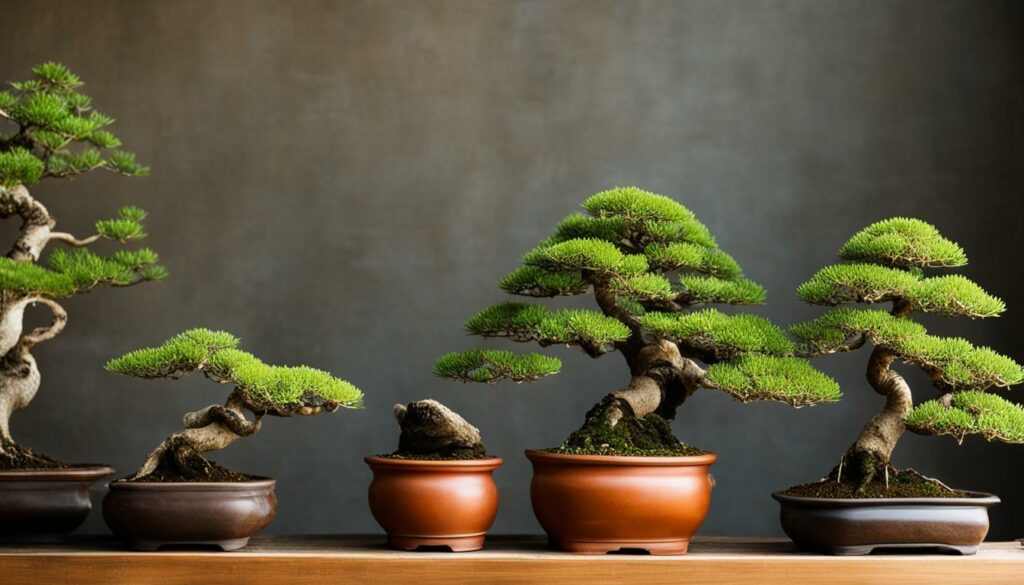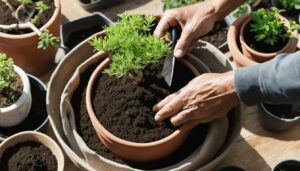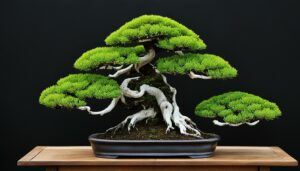Are you struggling with managing the growth rates of your bonsai trees? Do you want to learn effective strategies for controlling their development and size? Bonsai cultivation requires patience, dedication, and precise care to achieve the desired growth rates and appearance of these miniature trees.
In this section, we will explore various development techniques and cultivation strategies that you can use to manage the growth rates and control the development of your bonsai trees. From pruning to fertilization, we will guide you every step of the way to help you create stunning miniature trees.
Key Takeaways:
- Bonsai cultivation requires precise care to achieve desired growth rates and appearance.
- Effective development techniques such as pruning and fertilization can help manage growth rates.
- Choosing the right bonsai species is crucial for growth rate control.
- Patience and dedication are vital for bonsai cultivation.
- Continuous learning and adaptation are essential for successful bonsai growth and development.
Understanding Bonsai Growth Control
To effectively manage the growth rates of your bonsai trees, it’s crucial to understand the concept of bonsai growth control. Unlike regular trees, bonsai trees are grown in small containers and are pruned, wired, and trained to achieve a particular size and shape.
The growth of bonsai trees is influenced by various factors, including species, age, environment, and cultivation techniques. Typically, the roots and trunk of a bonsai will grow slower than its branches, which means controlling the size and growth rate of the foliage is essential.
By applying growth control techniques such as pruning, wiring, and root pruning, you can shape and maintain your bonsai trees’ desired size. However, it’s important to note that different species of bonsai trees have different growth rates, so selecting the right tree is crucial when it comes to growth control.
The Factors That Influence Bonsai Sizing and Growth Control
Several factors can influence the sizing and growth rate of your bonsai tree. These include:
| Factor | Description |
|---|---|
| Species | Each species of bonsai tree has its growth rate and response to different growth control techniques. |
| Roots | The roots of bonsai trees play a significant role in their growth. Proper root pruning and potting can help control the growth rate. |
| Pruning and Training | Pruning and wiring are two essential bonsai tree growth control techniques used to shape and control the tree’s growth. |
| Environment | The environment, including light, temperature, and humidity, can have an impact on tree growth rates. |
| Fertilization and Nutrient Control | Proper fertilization is necessary to ensure the health and growth of bonsai trees. |
By understanding the factors that influence bonsai sizing and growth control, you can create a suitable environment for your trees and apply the right growth control techniques. In the next section, we will dive deeper into how to choose the right bonsai tree species for growth control.
Choosing the Right Bonsai Species for Control
Bonsai cultivation involves selecting the right species of trees that are capable of adapting to the conditions and techniques employed in bonsai cultivation. Not all species of tree make appropriate bonsai due to their growth rate, size, and other factors. Thus, it is important to choose the right species of bonsai for growth rate control and development.
Factors to Consider
- The Growth Rate: Different bonsai species grow at different rates. Some species, such as Japanese Maple and Chinese Elm, grow slowly and are ideal for bonsai cultivation, while others, such as Weeping Willow, grow quickly and are difficult to control. Thus, it is crucial to select species that have a slow to moderate growth rate.
- The Size: Bonsai trees are miniature trees, so selecting species with a small size and fine leaves is paramount. The species must also have strong branches and trunk to handle the stress of pruning and wiring.
- The Location: It is essential to choose bonsai species that can adapt to the climatic conditions of your location.
- The Overall Health: The species must be healthy and free from pests and diseases.
Below are some popular bonsai species that have slow to moderate growth rates and are ideal for growth control and development:
| Bonsai Species | Growth Rate | Size (Approximate) | Leaves |
|---|---|---|---|
| Japanese Maple | Slow | Up to 3 feet | Small, fine |
| Chinese Elm | Slow to moderate | Up to 2 feet | Small, oval |
| Trident Maple | Slow | Up to 2 feet | Small, lobed |
| Juniper | Slow to moderate | Up to 2 feet | Small, needle-like |
Choosing the right bonsai species for growth control and development will lay the foundation for a successful and rewarding bonsai cultivation journey.
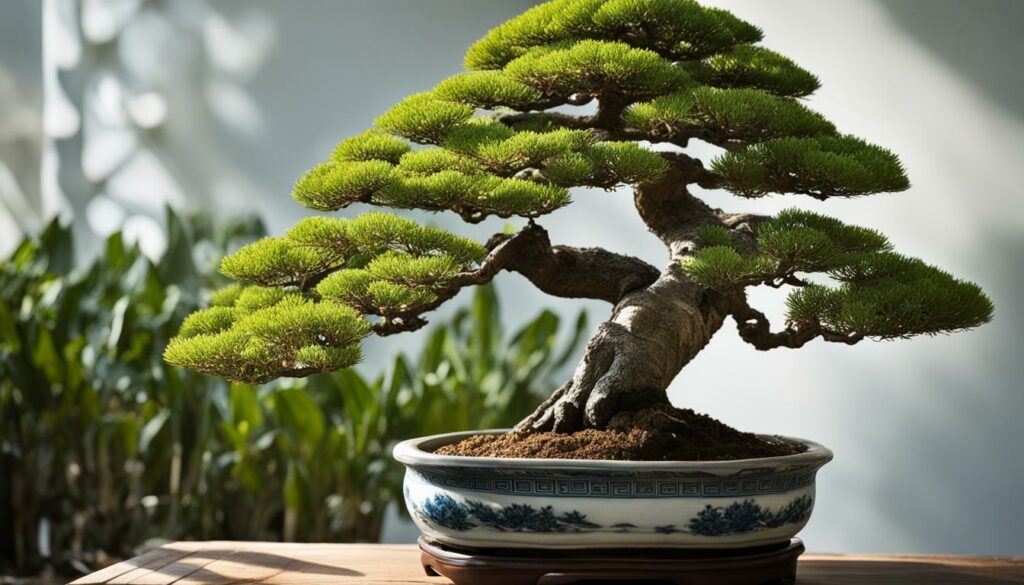
Pruning Techniques for Growth Control
Pruning is a crucial technique that can help control the growth of bonsai trees. Regular pruning of the bonsai tree encourages the growth of new branches and foliage while preventing the growth of unwanted branches. The following are some effective pruning techniques for growth control:
- Pinching: This involves removing the new growth at the tips of branches with your fingers. Pinching promotes backbudding and branching, which leads to denser foliage and a compact growth habit.
- Root Pruning: By selectively removing roots, you can limit the tree’s ability to absorb water and nutrients, thereby slowing its growth. Root pruning should be done carefully and only as needed to maintain the tree’s health.
- Thinning: This technique involves removing some of the branches and foliage selectively. Thinning reduces the density of the foliage, allowing more light and air to reach the remaining branches. This technique is particularly useful for maintaining a balanced shape.
- Branch Shortening: By cutting back the length of the branches, you can control the tree’s overall size and shape. This technique is particularly useful for maintaining a compact form.
Pruning can be an intimidating technique, but with practice and careful observation, it becomes easier. Remember to use sharp and clean pruning tools to prevent damage to the tree. It’s also important to prune your bonsai regularly as neglecting pruning can lead to uncontrolled growth and a loss of the tree’s shape.
Wiring and Training for Size and Shape
Wiring is a popular technique used in bonsai cultivation to shape and control the growth of trees. By wrapping copper or aluminum wire around branches and trunk, you can direct the growth of the tree in a desired direction. However, improper wiring techniques can damage the tree, so it’s important to learn how to wire properly.
The first step is to choose the right wires, which vary in size depending on the thickness of the branch. Thicker branches may require multiple wires to hold them in place. Before wiring, ensure the branch is flexible by slightly bending it. Then, starting from the bottom, wrap the wire around the branch. The wire should be wrapped in a spiral shape, with each turn being at a 45-degree angle to the previous one. The wire should be snug, but not too tight as to dig into the bark and cause damage.
Training is another technique used to shape the tree by pruning and wiring the branches. Training creates the tree’s structure and determines its overall shape. To start training a tree, first, understand the desired shape. Then, create a wire frame that closely follows the shape you wish to achieve. Finally, wire and prune the branches to direct the tree’s growth within the frame.
Bonsai cultivation is an art that takes practice and patience. When wiring, take your time and remember to remove the wires once they have done the job to prevent damage to the bark. With proper training and wiring techniques, you can create stunning bonsai trees of any desired size and shape.
Root Pruning and Repotting for Growth Control
Bonsai trees require appropriate care to ensure optimal growth rates and control. One significant aspect of bonsai cultivation is proper root pruning and repotting. The roots of bonsai trees play a crucial role in their growth and development. Root pruning helps to maintain the appropriate root-to-top ratio, which is essential for controlling growth rates.
Root pruning involves trimming the roots of your bonsai tree to control its size and promote healthy growth. When the roots of a bonsai outgrow the pot or become pot-bound, it’s time to repot. Repotting provides more space for the roots to grow and allows you to replace the old soil with fresh, nutrient-rich soil.
When root pruning, it’s essential to be mindful of the amount removed to avoid damaging the bonsai. The amount of roots to prune depends on the size of the plant. For larger bonsai, remove up to one-third of the roots. For smaller bonsai, prune up to half the root mass.
Repotting your bonsai also depends on the size of the pot. For smaller bonsai, repotting every year or two is essential. For larger bonsais, it can take up to five years to repot.
Now that you know the importance of proper root pruning and repotting, it’s time to learn how to perform it correctly. Please refer to the following instructions when performing root pruning and repotting on your bonsai tree:
Root Pruning
- Remove the bonsai tree from the pot.
- Gently remove the soil from the roots using a root hook or chopstick.
- Trim the roots using sharp scissors or pruning shears, removing roughly one-third to half of the root mass, depending on the size of the plant. Cut at an angle away from the plant.
- Remove any dead or damaged roots.
- Next, spread out the remaining roots uniformly and repot.
Repotting
- Remove the bonsai tree from the pot.
- Clean the pot thoroughly.
- Add a drainage layer of coarse sand or gravel to the bottom of the pot.
- Add a layer of fresh, nutrient-dense soil to the pot.
- Place the bonsai tree in the center and ensure it’s at the correct height.
- Fill in the remaining space with soil, tamping it down carefully.
- Water the bonsai thoroughly and let it drain thoroughly.
When root pruning, repotting, or any other bonsai cultivation method, it is essential to maintain patience and care. Bonsai cultivation is a journey that requires time and dedication. With proper care, you can successfully control the growth rate of your bonsai, promoting its health and development.
Fertilization and Nutrient Control
Proper nourishment is vital for the growth and development of bonsai trees. Fertilization helps provide the essential nutrients required for healthy growth, including nitrogen, phosphorus, and potassium.
It is important to choose the right type of fertilizer for your bonsai species and growth stage. Slow-release fertilizers are ideal as they provide consistent feeding over a more extended period. Avoid over-fertilization, which causes the accumulation of salts, scorching the roots, and harming the tree.
Regularly check the soil’s pH level and adjust it as necessary by adding lime or sulfur to maintain optimal nutrient uptake. Be mindful of the time of the year and adjust fertilization accordingly. During the growing season, fertilize once a month, while during fall and winter, reduce to once every two months.
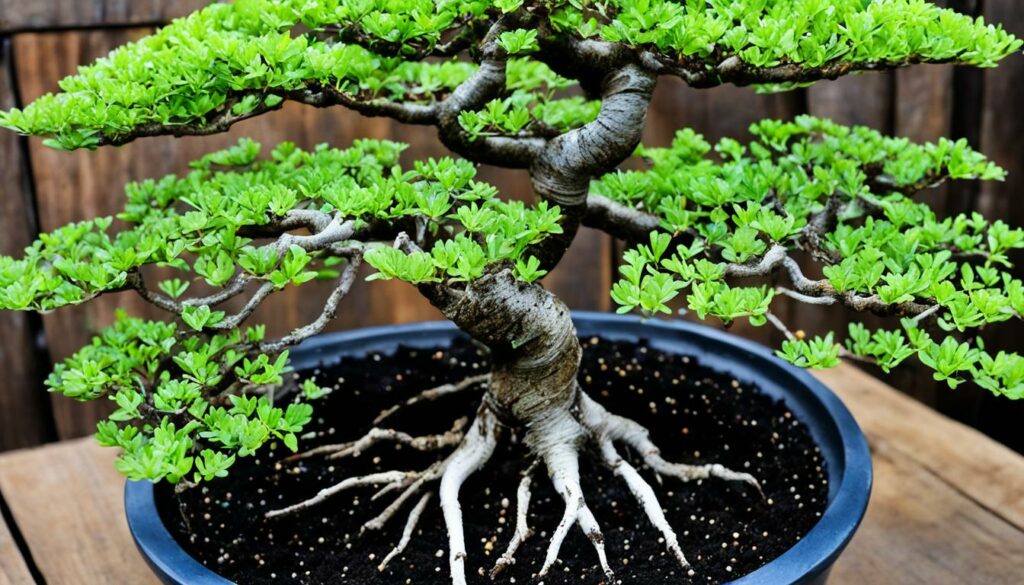
Remember that proper nutrient control is crucial for managing growth rates and maintaining good health. By following these tips, you can ensure your bonsai receives the necessary nourishment for optimal growth and development.
Watering Techniques for Growth Control
Watering is a fundamental aspect of bonsai tree care. Proper watering techniques are essential in supporting optimal growth rates, ensuring your miniaturized trees remain healthy and vibrant. However, over-watering or under-watering can negatively impact your bonsai’s growth and development. Below are some useful watering techniques for growth control that you can incorporate in your bonsai tree care regimen:
- Check Soil Moisture Levels: Before watering your bonsai, check the soil moisture levels using a moisture meter or by sticking your finger a few inches into the soil. If the soil feels dry, it’s time to water your tree.
- Watering Frequency: The watering frequency depends on the environmental conditions and the size of your bonsai tree. In general, bonsai trees require watering once a day during hot weather and once in a few days during colder conditions. However, it’s essential to observe your bonsai’s soil moisture levels and adjust the frequency as necessary.
- Watering Method: Water your bonsai thoroughly, ensuring that the soil is saturated but not waterlogged. Avoid watering the foliage to prevent fungal growth. Instead, water the soil until the excess water drains from the drainage holes at the bottom of the pot.
- Humidity: Bonsai trees thrive in high humidity conditions. Using a humidity tray or a humidifier can help maintain optimal humidity levels, supporting healthy growth rates.
- Seasonal Considerations: The frequency and amount of watering should be adjusted based on seasonal changes and weather conditions. During the winter season, the watering frequency should be reduced to avoid root rot caused by waterlogged soil.
By incorporating these watering techniques into your bonsai tree care routine, you can effectively manage the growth and development of your miniature trees.
Light and Temperature Considerations
Proper light exposure and temperature control are crucial for maintaining the growth and health of bonsai trees. Providing your bonsai with the right amount and intensity of light can directly impact its growth rate and overall development. Similarly, temperature fluctuations can cause stress and damage to your trees, negatively affecting their growth.
When it comes to light, it’s essential to choose the right location for your bonsai where it can receive adequate sunlight. Generally, bonsai trees require bright, indirect light for optimum growth. The amount of light exposure needed may differ according to the species, so it’s essential to research your bonsai’s specific light requirements. If natural light is insufficient or absent, consider using artificial lights such as fluorescent lamps or LED grow lights.
However, direct sunlight exposure can be harmful to some bonsai species, causing sunburn and leaf scorching. In this case, it is best to diffuse the light or provide partial shade to your trees. Additionally, during hot summer months, you may need to provide extra shade or protection for your trees to prevent wilting and stress.
Temperature is another environmental factor that can affect the growth and development of bonsai trees. Bonsai trees typically grow well in moderate temperatures between 60-75°F (15-24°C). Extreme temperature fluctuations can cause damage to the roots, foliage, and overall growth of your bonsai.
If you live in a climate where the temperature falls below 50°F (10°C), it’s best to bring your bonsai indoors or provide extra protection to prevent frost damage. On the other hand, if the temperature rises above 85°F (29°C), you might need to increase watering frequency or provide extra shade to prevent heat stress.
Remember to keep a close eye on your bonsai and adjust its light exposure and temperature control according to its specific needs to maintain optimal growth rates.
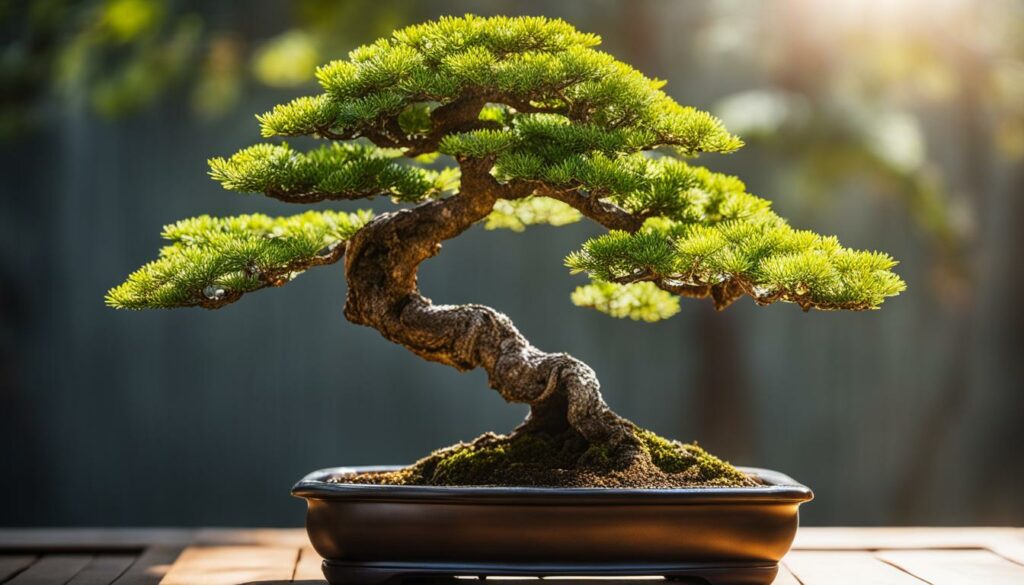
Disease and Pest Control Measures
Bonsai trees are susceptible to various diseases and pests, which can cause stunted growth, wilting, yellowing leaves, and even death. To prevent these problems, it is essential to implement appropriate disease and pest control measures.
Preventive Measures:
To minimize the risk of disease and pest infestation, you should practice good hygiene and maintain a clean and healthy environment for your bonsai. This includes:
- Regularly removing dead leaves, branches, and debris from the soil surface to prevent the growth of fungal spores.
- Using sterilized tools to trim and shape your bonsai to prevent disease transmission between plants.
- Avoiding overwatering or underwatering your bonsai, as this can weaken the plant and make it more susceptible to pests.
- Keeping an eye out for early signs of disease or pest infestation, such as unusual spots on the leaves or sticky residue on the plant’s trunk or branches.
Treatment options:
If you notice any disease or pest problems in your bonsai, it is crucial to act quickly to prevent the problem from spreading. Treatment options may include:
| Treatment | Description |
|---|---|
| Biological Control | This method involves using natural predators such as ladybugs or praying mantises to control pest populations. |
| Chemical Control | This method involves using pesticides or fungicides to treat disease or pest infestations. It is essential to choose the appropriate chemical and follow the instructions carefully to avoid harming the bonsai. |
| Cultural Control | This method involves changing the environmental conditions to discourage pests or disease development. Examples include adjusting the temperature or humidity levels or changing the soil type. |
| Mechanical Control | This method involves physically removing pests from the plant by hand or using a jet of water or insecticidal soap. |
By implementing effective disease and pest control measures, you can ensure the health and vitality of your bonsai, allowing it to thrive and grow to its full potential.
Seasonal Care for Controlled Growth
Proper seasonal care is crucial for managing the growth rates and overall health of your bonsai trees. Different seasons require specific care, which can impact the growth and development of your trees. Here are some seasonal care practices to promote controlled growth:
Spring Care
In spring, make sure to remove any winter protection and check for any damage caused by frost. Spring is also an ideal time for repotting and root pruning.
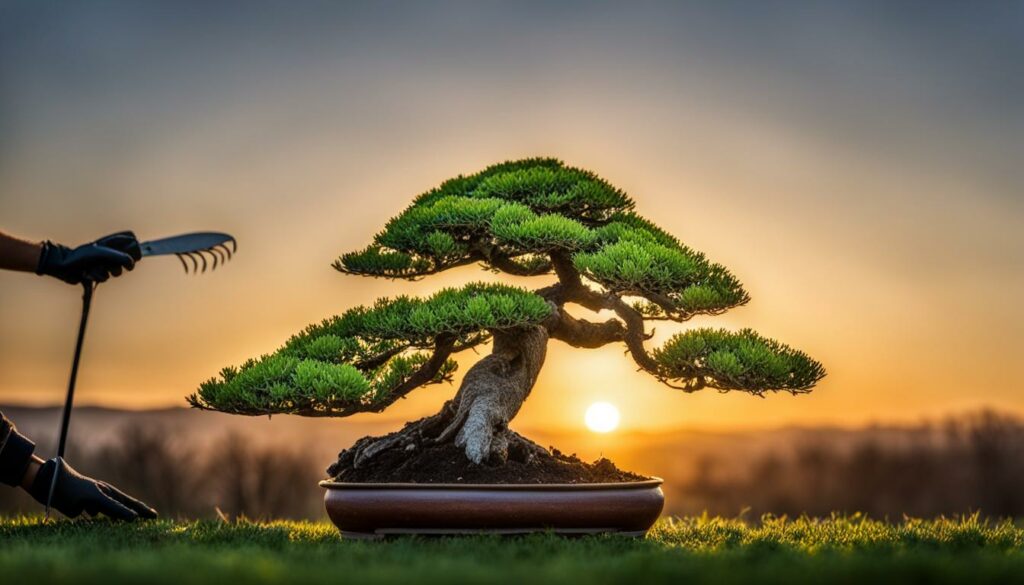
Summer Care
During summer, provide plenty of sunlight and water to keep your bonsai thriving. Pruning and wiring should also be done during this season to control growth and maintain desired shape.
Fall Care
In fall, reduce watering and fertilizer frequency to prepare your bonsai for dormancy. This is also a good time for pruning, as the slower growth allows for better healing.
Winter Care
Winter care is crucial for the survival of your bonsai. Protect your tree from freezing temperatures and provide appropriate lighting. Watering should be reduced, but make sure the soil doesn’t dry out completely.
By following these seasonal care practices, you can ensure the controlled growth and development of your bonsai tree throughout the year.
Troubleshooting Common Growth Issues
Despite your best efforts, bonsai trees may still encounter growth issues. In this section, we will address some of the most common growth problems that bonsai enthusiasts face and provide troubleshooting tips to help you overcome them.
Problem: Slow Growth
If your bonsai is growing slowly, it may be due to insufficient light, improper watering, or lack of nutrients. Make sure your bonsai receives adequate sunlight, adjust your watering routine if necessary (avoid overwatering or underwatering), and fertilize appropriately.
Problem: Yellowing Leaves
Yellowing leaves can be a sign of overwatering, underwatering, or nutrient deficiency. Check your watering routine and adjust as necessary, and ensure your bonsai is receiving the proper nutrients through fertilization.
Problem: Wilting Leaves
If your bonsai’s leaves are wilting, it may be due to overwatering or underwatering. Check the soil and adjust your watering routine accordingly.
Problem: Pests and Diseases
Bonsai trees are susceptible to pests and diseases just like any other plant. Keep an eye out for common pests such as spider mites, scale insects, and aphids, and use appropriate pest control measures to combat infestations. In addition, ensure your bonsai is being properly cared for to prevent diseases such as root rot or fungal infections.
If you are still experiencing growth issues with your bonsai, seek advice from experienced gardeners or consult a bonsai expert for further guidance.
The Art of Patience in Bonsai Cultivation
Bonsai cultivation is a rewarding hobby that requires patience and dedication. As you work to manage the growth rates and control the development of your bonsai trees, it is important to remember that Rome wasn’t built in a day. Similarly, bonsai trees take time to grow and develop into the masterpieces that they can be.
It can be tempting to rush the growth process and try to speed up the development of your bonsai. However, this can lead to stunted growth, damaged trees, and frustration. On the other hand, if you are patient and take the time to properly care for your bonsai, you will be rewarded with healthy, beautiful trees that you can be proud of.
One of the key ways to exercise patience in bonsai cultivation is to resist the urge to prune or wire your trees too often. While these techniques can be effective in controlling growth, it is important to give your bonsai time to recover and regain strength before attempting any further shaping or adjustments.
Another way to practice patience is to allow your bonsai to grow at its own pace and resist the temptation to force it into a desired shape or size. While it may be tempting to speed up the process and achieve immediate results, it is important to remember that the true beauty of bonsai lies in their natural form, shaped by time and careful cultivation.
With patience and perseverance, you can create beautiful bonsai trees that are the envy of all who see them. Remember to take your time, enjoy the journey, and embrace the art of patience in bonsai cultivation.
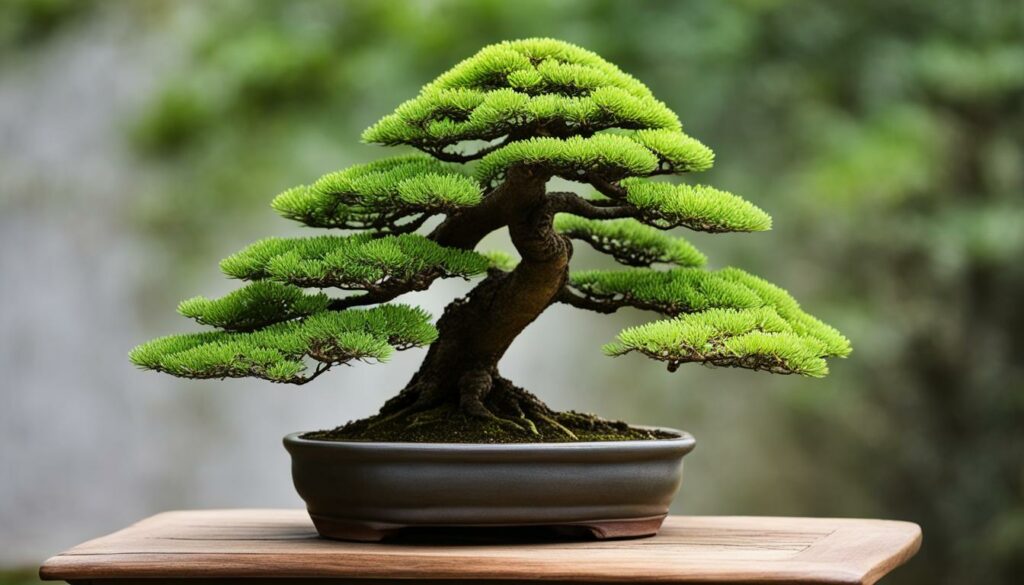
Conclusion
Managing the growth rates and controlling the development of your bonsai trees require a combination of effective cultivation strategies. By using pruning techniques, wiring, and training methods, root pruning, fertilization, and nutrient control, watering techniques, environmental considerations, disease, and pest control measures, and seasonal care practices, you can achieve the desired growth rates and shapes of your bonsai trees.
It is essential to understand that bonsai cultivation is a continuous learning process that requires patience, dedication, and adaptation. With the right techniques and care, you can create stunning miniature trees that reflect your passion and creativity. Remember to select the right bonsai species suitable for growth rate control and development.
Through this article, we hope that you have gained insights into effective strategies for managing bonsai cultivation growth rates and control. We encourage you to implement these techniques and continue learning to perfect the art of bonsai cultivation. Start your journey today and create beautiful, miniature trees that inspire and amaze.
FAQ
What is bonsai growth control?
Bonsai growth control refers to the techniques and methods used to manage and regulate the growth rate of bonsai trees. It involves shaping, pruning, and training the trees to achieve the desired size and shape.
How does bonsai growth control work?
Bonsai growth control works by manipulating the tree’s growth patterns through various methods such as pruning, wiring, root pruning, repotting, and proper nutrient control. These techniques help maintain the bonsai’s small size and shape.
Which bonsai species are suitable for growth rate control?
Not all bonsai species have the same growth rates or response to growth control techniques. Some popular bonsai species suitable for growth rate control include junipers, pines, maples, and ficus trees. It is important to research the specific growth characteristics of each species before choosing one for growth control.
What are the pruning techniques used for growth control?
Pruning is an essential technique for controlling bonsai growth. It involves cutting back branches and foliage to maintain the desired shape and size. Pruning techniques include directional pruning, thinning, and pinching.
How can wiring and training techniques help with bonsai growth control?
Wiring and training techniques involve wrapping wires around branches and trunk to shape and control their growth. Proper wiring and training can help achieve the desired size and shape of the bonsai tree.
What is root pruning and repotting?
Root pruning is the process of trimming and pruning the roots of a bonsai tree. This helps control the growth rate and maintains a healthy root system. Repotting involves transferring the bonsai tree to a new pot, providing fresh soil and pruning the roots to keep them in check.
How does fertilization and nutrient control affect bonsai growth rate?
Proper fertilization and nutrient control are essential for maintaining the health and growth of bonsai trees. They provide the necessary nutrients for controlled growth and development.
What are the best watering techniques for bonsai growth control?
Proper watering is crucial for controlling bonsai growth rates. It is important to water the bonsai thoroughly but not excessively to maintain optimal growth. Techniques such as soaking, misting, and using humidity trays can help ensure proper watering.
How do light and temperature impact bonsai growth control?
Light and temperature are important factors in bonsai growth control. Different species have different light and temperature requirements. Providing the right amount of light and maintaining appropriate temperature conditions can help regulate growth rates.
How can I prevent diseases and pests that affect bonsai growth?
Preventive measures such as regular inspections, proper hygiene, and using appropriate pest-control techniques can help prevent diseases and pests from affecting bonsai growth. Immediate treatment should be applied if any signs of infestation or disease are detected.
What seasonal care practices are necessary for bonsai growth control?
Seasonal care practices, such as adjusting watering frequency, providing winter protection, and adjusting fertilizer applications, are essential for managing bonsai growth rates throughout the year. Adapting care techniques to each season helps maintain controlled growth.
What are some common growth issues in bonsai cultivation?
Common growth issues in bonsai cultivation include stunted growth, weak branches, yellowing leaves, and root rot. These can be caused by factors such as improper watering, nutrient deficiencies, pests, diseases, or incorrect pruning techniques.
Why is patience important in bonsai cultivation?
Patience is crucial in bonsai cultivation because the process of controlling growth and developing a masterpiece takes time. Bonsai trees require continuous care, adaptation, and growth monitoring to achieve the desired results. The rewards of patience are the creation of stunning miniature trees that reflect your dedication.
